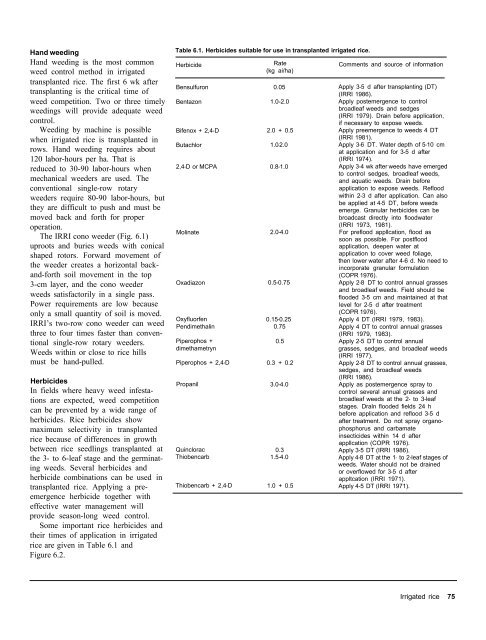A handbbok on Weed Control in Rice.pdf
A handbbok on Weed Control in Rice.pdf
A handbbok on Weed Control in Rice.pdf
Create successful ePaper yourself
Turn your PDF publications into a flip-book with our unique Google optimized e-Paper software.
Hand weed<strong>in</strong>g<br />
Hand weed<strong>in</strong>g is the most comm<strong>on</strong><br />
weed c<strong>on</strong>trol method <strong>in</strong> irrigated<br />
transplanted rice. The first 6 wk after<br />
transplant<strong>in</strong>g is the critical time of<br />
weed competiti<strong>on</strong>. Two or three timely<br />
weed<strong>in</strong>gs will provide adequate weed<br />
c<strong>on</strong>trol.<br />
<strong>Weed</strong><strong>in</strong>g by mach<strong>in</strong>e is possible<br />
when irrigated rice is transplanted <strong>in</strong><br />
rows. Hand weed<strong>in</strong>g requires about<br />
120 labor-hours per ha. That is<br />
reduced to 30-90 labor-hours when<br />
mechanical weeders are used. The<br />
c<strong>on</strong>venti<strong>on</strong>al s<strong>in</strong>gle-row rotary<br />
weeders require 80-90 labor-hours, but<br />
they are difficult to push and must be<br />
moved back and forth for proper<br />
operati<strong>on</strong>.<br />
The IRRI c<strong>on</strong>o weeder (Fig. 6.1)<br />
uproots and buries weeds with c<strong>on</strong>ical<br />
shaped rotors. Forward movement of<br />
the weeder creates a horiz<strong>on</strong>tal back-<br />
and-forth soil movement <strong>in</strong> the top<br />
3-cm layer, and the c<strong>on</strong>o weeder<br />
weeds satisfactorily <strong>in</strong> a s<strong>in</strong>gle pass.<br />
Power requirements are low because<br />
<strong>on</strong>ly a small quantity of soil is moved.<br />
IRRI’s two-row c<strong>on</strong>o weeder can weed<br />
three to four times faster than c<strong>on</strong>ven-<br />
ti<strong>on</strong>al s<strong>in</strong>gle-row rotary weeders.<br />
<strong>Weed</strong>s with<strong>in</strong> or close to rice hills<br />
must be hand-pulled.<br />
Herbicides<br />
In fields where heavy weed <strong>in</strong>festati<strong>on</strong>s<br />
are expected, weed competiti<strong>on</strong><br />
can be prevented by a wide range of<br />
herbicides. <strong>Rice</strong> herbicides show<br />
maximum selectivity <strong>in</strong> transplanted<br />
rice because of differences <strong>in</strong> growth<br />
between rice seedl<strong>in</strong>gs transplanted at<br />
the 3- to 6-leaf stage and the germ<strong>in</strong>at<strong>in</strong>g<br />
weeds. Several herbicides and<br />
herbicide comb<strong>in</strong>ati<strong>on</strong>s can be used <strong>in</strong><br />
transplanted rice. Apply<strong>in</strong>g a preemergence<br />
herbicide together with<br />
effective water management will<br />
provide seas<strong>on</strong>-l<strong>on</strong>g weed c<strong>on</strong>trol.<br />
Some important rice herbicides and<br />
their times of applicati<strong>on</strong> <strong>in</strong> irrigated<br />
rice are given <strong>in</strong> Table 6.1 and<br />
Figure 6.2.<br />
Table 6.1. Herbicides suitable for use <strong>in</strong> transplanted irrigated rice.<br />
Herbicide<br />
Bensulfur<strong>on</strong><br />
Bentaz<strong>on</strong><br />
Bifenox + 2,4-D<br />
Butachlor<br />
2,4-D or MCPA<br />
Mol<strong>in</strong>ate<br />
Oxadiaz<strong>on</strong><br />
Oxyfluorfen<br />
Pendimethal<strong>in</strong><br />
Piperophos +<br />
dimethametryn<br />
Piperophos + 2,4-D<br />
Propanil<br />
Qu<strong>in</strong>clorac<br />
Thiobencarb<br />
Thiobencarb + 2,4-D<br />
Rate<br />
(kg ai/ha)<br />
0.05<br />
1.0-2.0<br />
2.0 + 0.5<br />
1.0-2.0<br />
0.8-1.0<br />
2.0-4.0<br />
0.5-0.75<br />
0.15-0.25<br />
0.75<br />
0.5<br />
0.3 + 0.2<br />
3.0-4.0<br />
0.3<br />
1.5-4.0<br />
1.0 + 0.5<br />
Comments and source of <strong>in</strong>formati<strong>on</strong><br />
Apply 3-5 d after transplant<strong>in</strong>g (DT)<br />
(IRRI 1986).<br />
Apply postemergence to c<strong>on</strong>trol<br />
broadleaf weeds and sedges<br />
(IRRI 1979). Dra<strong>in</strong> before applicati<strong>on</strong>,<br />
if necessary to expose weeds.<br />
Apply preemergence to weeds 4 DT<br />
(IRRI 1981).<br />
Apply 3-6 DT. Water depth of 5-10 cm<br />
at applicati<strong>on</strong> and for 3-5 d after<br />
(IRRI 1974).<br />
Apply 3-4 wk after weeds have emerged<br />
to c<strong>on</strong>trol sedges, broadleaf weeds,<br />
and aquatic weeds. Dra<strong>in</strong> before<br />
applicati<strong>on</strong> to expose weeds. Reflood<br />
with<strong>in</strong> 2-3 d after applicati<strong>on</strong>. Can also<br />
be applied at 4-5 DT, before weeds<br />
emerge. Granular herbicides can be<br />
broadcast directly <strong>in</strong>to floodwater<br />
(IRRI 1973, 1981).<br />
For preflood appllcati<strong>on</strong>, flood as<br />
so<strong>on</strong> as possible. For postflood<br />
applicati<strong>on</strong>, deepen water at<br />
applicati<strong>on</strong> to cover weed foliage,<br />
then lower water after 4-6 d. No need to<br />
<strong>in</strong>corporate granular formulati<strong>on</strong><br />
(COPR 1976).<br />
Apply 2-8 DT to c<strong>on</strong>trol annual grasses<br />
and broadleaf weeds. Field should be<br />
flooded 3-5 cm and ma<strong>in</strong>ta<strong>in</strong>ed at that<br />
level for 2-5 d after treatment<br />
(COPR 1976).<br />
Apply 4 DT (IRRI 1979, 1983).<br />
Apply 4 DT to c<strong>on</strong>trol annual grasses<br />
(IRRI 1979, 1983).<br />
Apply 2-5 DT to c<strong>on</strong>trol annual<br />
grasses, sedges, and broadleaf weeds<br />
(IRRI 1977).<br />
Apply 2-8 DT to c<strong>on</strong>trol annual grasses,<br />
sedges, and broadleaf weeds<br />
(IRRI 1986).<br />
Apply as postemergence spray to<br />
c<strong>on</strong>trol several annual grasses and<br />
broadleaf weeds at the 2- to 3-leaf<br />
stages. Draln flooded fields 24 h<br />
before applicati<strong>on</strong> and reflood 3-5 d<br />
after treatment. Do not spray organophosphorus<br />
and carbamate<br />
<strong>in</strong>secticides with<strong>in</strong> 14 d after<br />
appllcati<strong>on</strong> (COPR 1976).<br />
Apply 3-5 DT (IRRI 1986).<br />
Apply 4-8 DT at the 1- to 2-leaf stages of<br />
weeds. Water should not be dra<strong>in</strong>ed<br />
or overflowed for 3-5 d after<br />
appltcati<strong>on</strong> (IRRI 1971).<br />
Apply 4-5 DT (IRRI 1971).<br />
Irrigated rice 75











